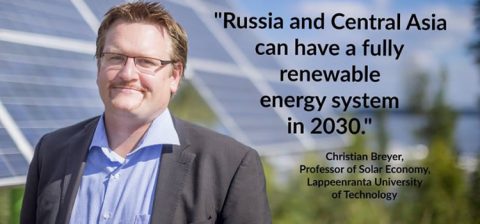
‘Binnen 15 jaar kan heel Rusland een duurzame energievoorziening hebben’
6 januari 2016 – Een Fins onderzoek heeft berekend dat heel Rusland en Centraal Azië binnen 15 jaar een volledig duurzame energievoorziening kunnen hebben en dan ook nog 20% op de energiekosten kunnen besparen.
Onderzoekers van Lappeenranta University of Technology in Finland ontwikkelden een model voor een energiesysteem waarbij de hele energievoorziening van Rusland en Centraal Azië draait op zonne-energie, windenergie, waterkracht, biomassa en geothermie.
Uit een bericht van Lappeenranta University of Technology
‘(…) “We think that this is the first ever 100% renewable energy system modelling for Russia and Central Asia. It demonstrates that Russia can become one of the most energy-competitive regions in the world”, emphasises professor Christian Breyer, co-author of the study.
Moving to a renewable energy system is possible due to the abundance of various types of renewable energy resources in the area. This then enables the building of a Super Grid, which connects different energy resources of the researched area.
Such a renewable energy system represents a drastic change compared to the current situation. The modelled energy system is based on wind, hydropower, solar, biomass and some geothermal energy. Wind amounts to about 60 percent of the production whilst solar, biomass and hydropower are distributed evenly. The total installed capacity of renewable energy in the system is about 550 gigawatts. Slightly more than half of this is wind energy and 20 percent is solar. The rest is composed of hydro and biomass supported with power-to-gas, pumped hydro storage and batteries. In the present situation, the total capacity is 388 gigawatts of which wind and solar only accounts for 1.5 gigawatts. The current system also has neither power-to-gas capacity nor batteries.
The geographical area of the research covers much of the northern hemisphere. Many of the countries in the area are currently reliant on the production and use of fossil fuels and nuclear power. In addition to Russia, the researched area includes Belarus, Kazakhstan, Uzbekistan, Turkmenistan as well as Caucasus and Pamir regions including Armenia, Azerbaijan and Georgia, and Kirgizstan and Tajikistan.
One of the key insights of the research is that energy sectors’ integration lowers the cost of electricity by 20 percent for Russia and Central Asia. When moving to a renewable energy system, for example, natural gas is replaced with power-to-gas, i.e. converting electricity into gases, such as hydrogen and synthetic natural gas. This increases the overall need for renewable energy. The more renewable capacity is built the more it can be used for different sectors: heating, transportation and industry. This flexibility of the system decreases the need for storages and lowers the cost of energy.
The research was done as part of Neo-Carbon Energy research project, which has previously shown that a renewable energy system is also economically sensible in North-East Asia, South-East Asia, South America and Finland. (…)’
Bronnen
Lappeenranta University of Technology, 30 december 2015: Russia can be one of the most energy-competitive areas based on renewables
ResearchGate, Rapport, 12 november 2015: Eurasian Super Grid for 100% Renewable Energy power supply: Generation and storage technologies in the cost optimal mix
Neo Carbon Energy Project



